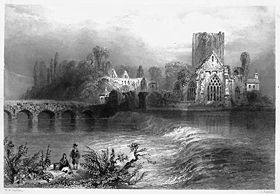The annual nine day Solemn Novena to Our Lady of Perpetual Help will commence in Holycross Abbey, Thurles , Co.Tipperary, on Tuesday next September 8th and continue daily until Wednesday, September 16th . The Abbey’s parish priest is presently Rev.Fr. Thomas Breen.
Mass Times for this years Solemn Novena
Daily Times
Abbey: 7.00 a.m. – 10.30 a.m. – 4.30 p.m. – 7.30. p.m. – 9.30. p.m.
Marquee: 10.30 a.m. – 4.30 p.m. – 7.30 p.m. – 9.30 p.m.
(Note: Confessions before, during and after each session.)Sunday Times
Abbey: 7.00 a.m. – 10.30 a.m. – 12.30. p.m. – 2.30. p.m. – 7.30 p.m. 9.30 p.m.
Marquee: 10.30. a.m. – 12.30. p.m. – 2.30. p.m. – 7.30. p.m. and 9.30. p.m.
(Special Note: Special ceremony for the sick (anointing of the sick) on Saturday 2.30 p.m. during the Novena.)
During this Solemn Novena each year thousands of Christian pilgrims gather at this historic Abbey, in search and, more importantly, often finding the spiritual and natural healing they so earnestly seek in their lives.
History Of Holycross Abbey
The Holy Cross Abbey (Mainistir na Croise Naofa) is a now a beautifully restored Cistercian monastery in the village of Holycross, five miles from Thurles town. Situated on the River Suir (Abhainn na Siúire) this Abbey takes its name from a relic of the True Cross or Holy Rood. The fragment of that Holy Rood was brought to Ireland by the French Plantagenet Queen Isabella of Angouleme, in approximately 1233.
The beautiful Queen Isabella (1188 – 1246) was the second wife, and then widow of King John (1166 -1216 – Legendary enemy of English folklore hero Robin Hood). Queen Isabella married King John at the tender age of 12 years becoming mother of Henry 111, (Henry of Winchester). Following King John’s death she remarried one Hugh X of Lusignan and during her two marriages she gave issue to 14 children all of whom survived into adulthood.
Queen Isabella bestowed this relic on the original Cistercian Monastery in Thurles, which she then had reconstructed and from hence it derives it’s present name, ‘Holy Cross Abbey’.
Following the attempted dissolution of the monasteries through the Tudor conquest and the Cromwellian War (1649 – 1653), HolyCross Abbey slowly fell into ruins towards the middle of the 17th century, and instead now slowly become a place for public burial, amid its ruins, particularly after 1740.
Following special legislation in the Irish Parliament (Dáil Éireann) on its 50th anniversary,(21st of January 1969), Holy Cross Abbey was rightfully restored as a place of Roman Catholic worship and was correctly recognised primarily as a national Irish monument of great exception.
The Sacristan of St. Peter’s Basilica in Rome provided an authenticated relic of the Holy Cross, and the emblem of the Jerusalem Cross, also referred too as the Crusader Cross, has now been returned to the Abbey.
The thousands of tourists who make a pilgrimage to Holycross each year from all over the world, speak of the Abbey’s great beauty, peace and serenity.
Click here for Update


Leave a Reply